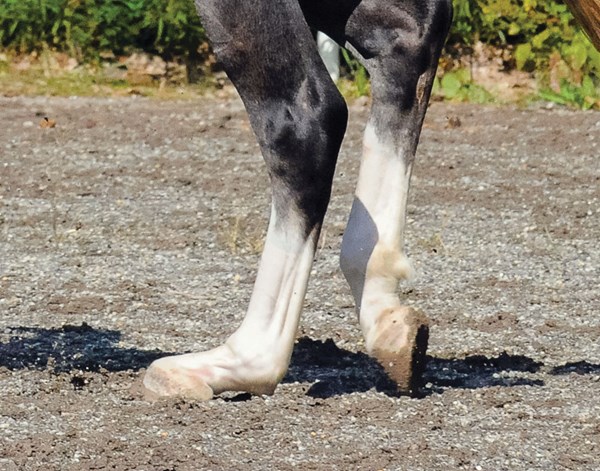If your horse has long, sloping pasterns with fetlocks that show excessive drop, or hyperextension, during movement, chances are you’ve worried about the impact of this structural characteristic on his soundness and longevity as a performance horse. And you’d be right to worry. The fetlock joint and its supporting structures play a crucial role in supporting your dressage horse’s movement. They need to stay healthy and strong.

Dusty Perin
To understand how you can best protect your horse’s fetlocks, it helps to understand the basic anatomy and biomechanics of the joint. Your horse’s fetlock joint forms the junction between his cannon bone and pastern and is supported by several soft-tissue structures that cradle the back of the joint, including the deep digital flexor tendon (DDFT), the superficial digital flexor tendon (SDFT) and the suspensory apparatus. The fetlock sinks toward the ground with every step your horse takes, making it a very important shock absorber. When it sinks, there is a resulting stretch in the supporting structures. In fact, both the SDFT and the suspensory are elastic structures—meaning they stretch like a spring, store energy then recoil to assist with propelling the leg off the ground.
What happens when there is excessive fetlock drop? In a perfect world, the elastic supporting structures stretch a little more, allowing them to recoil with additional energy and give your horse’s movement more spring. In a not-so-perfect world, the additional stretch of those supporting structures leads to damage, lameness and, in the most serious cases, breakdown. There are a number of different reasons why your horse might exhibit excessive fetlock drop—and the first step to protect his soundness is to recognize why it’s happening. Is it just one leg?
If you notice that one of your horse’s front or hind fetlocks drops more than the fetlock on the other side, it’s possible you’re seeing signs of low-grade weight-bearing lameness in the opposite limb. To avoid weighting the lame leg, your horse will put more weight on the other side—resulting in more fetlock drop on the sound side. Alternatively, a fetlock may show excessive drop if there has been damage to the supporting structures in the leg, such as the SDFT or suspensory apparatus. If one of these structures begins to break down, it will provide less effective support of the fetlock joint, allowing the fetlock to drop excessively during the weight-bearing portion of the stride.
No discussion of excessive fetlock drop would be complete without mentioning ESPA (equine systemic proteoglycan accumulation), formerly called DSLD or degenerative suspensory ligament desmitis.
This condition, believed to be inherited in many horses, is a whole-body connective-tissue abnormality that manifests itself by progressive breakdown of the suspensory apparatus—most commonly observed in the hind limbs. A horse with this condition will exhibit excessive fetlock drop and visible enlargement of the fetlock joint. Over time, the hock and stifle joints will straighten, giving the horse a post-legged appearance.
It is important to be aware of this condition—especially if you observe excessive drop of your horse’s hind fetlocks. It is a terribly painful, progressive disease that often goes unrecognized by well-meaning owners who attribute its appearance simply to conformation.
Because excessive fetlock drop can be an indicator of serious underlying problems, the first step you should take to protect your horse is to schedule an examination by your veterinarian.
He or she can perform an overall soundness evaluation, examine your horse’s fetlocks and perform stress tests to determine whether this is something more significant than a simple conformation trait.
If your vet determines that your horse’s excessive fetlock drop is just his normal structure, you can begin to focus your attention on keeping it that way. First, make sure to maintain proper balance of your horse’s feet. A tendency toward long toes and low heels can put additional stress on the fetlock joint if not corrected.
To manage this problem, your farrier will need to provide good heel support, which may be more successful if you keep your horse on a shorter shoeing interval—as short as four weeks between appointments in some situations. Be strict about footing, and avoid working your horse in very deep or uneven ground.
Pay close attention to his fitness and conditioning, and avoid repetitive work that will stress his soft-tissue structures. Beyond basic good management, if your horse displays excessive fetlock drop, the most important thing you can do to protect him is to monitor him closely for early signs of discomfort or injury.
Talk to your vet about performing an annual evaluation that is complete with flexion tests to confirm he is still healthy and strong.
Barb Crabbe, DVM, is a practicing equine veterinarian at Pacific Crest Sporthorse in Oregon City, Oregon. She is an active dressage rider and competitor who has claimed numerous Regional Championships and Horse-of-the-Year awards over the years. When she’s not in the saddle herself, she can be found ringside at the A-circuit hunter/jumper shows where her two daughters compete in hunters, jumpers and equitation.











